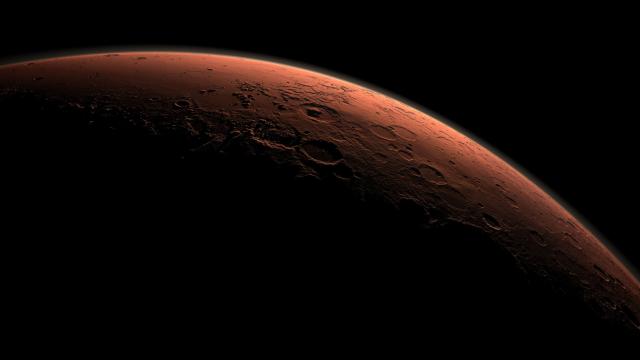New research details a biological solution for producing rocket fuel on Mars, but significant hurdles need to be overcome to make this intriguing idea work.
With plans to visit Mars next decade, NASA is still sorting out the fuel situation; launching a rocket to the Red Planet is not the issue — it’s getting a vehicle off the surface for the return trip home that’s posing a challenge. Copious amounts of methane and liquid nitrogen will be needed to produce the required propellant, but these key components of rocket fuel are as rare on Mars as fuel refineries.
New research published in Nature Communications estimates a cost of $US8 ($11) billion to ship the required 30 tons of methane and liquid oxygen to Mars. And that’s just for a single launch with a 454 T payload! With financial support from NASA’s Innovative Advanced Concepts program, the authors of the new paper have come up with a very different solution, in which key ingredients needed to produce the propellent can be sourced directly on the Red Planet.
These ingredients include carbon dioxide, frozen water, and sunlight. Cyanobacteria, also known as blue-green algae, and a bioengineered strain of E. coli bacteria would be brought to Mars from Earth, along with the materials required to build a large array of photobioreactors. Nick Kruyer, the first author of the new study and a researcher at Georgia Tech’s School of Chemical and Biomolecular Engineering, and his colleagues have outlined a production strategy in which the cyanobacteria, powered by sunlight and carbon dioxide, produce sugars that the E. coli then converts into a viable propellant.

Called 2,3-butanediol, it isn’t the most energetic propellant ever invented, but in the relative low-gravity environment on Mars, this rocket fuel will get the job done, the researchers argue. As a compound, 2,3-butanediol is already well known, as it’s used in the production of rubber, but scientists have never thought to use it as a propellant until now.
Other scientists had assumed that methane was the only solution, “as it is a high-energy fuel that can be made chemically from carbon dioxide, which is abundant on Mars,” Pamela Peralta-Yahya, a co-author of the study and an associate professor in the School of Chemistry & Biochemistry at Georgia Tech, explained to Gizmodo in an email. “A key insight of this paper is that a broader range of chemicals can be considered for use as propellant because Mars has one-third of the gravity of Earth — so you can use a less energy dense rocket propellant.”
The plastic materials shipped to Mars would be assembled into a photobioreactor array the size of four football fields. Photosynthesis and carbon dioxide would enable growth of the cyanobacteria, while enzymes in a separate reactor would break down the microorganisms into sugar. As Kruyer pointed out in a press release, “biology is especially good at converting CO2 into useful products,” making it a “good fit for creating rocket fuel.” At the E. coli stage, the separation of propellant from the fermentation broth would result in 95% purity, according to the paper.
The bioproduction of Martian rocket propellant would require 32% less power than NASA’s proposed chemical solution — that is, the plan to ship copious amounts of methane to Mars. It would produce 44 tons of excess clean oxygen, which would be put to good use by astronauts. What’s more, the proposed chemical solution would generate carbon monoxide as a byproduct, “which would need to be scrubbed,” said Peralta-Yahya. “Water electrolysis is envisioned, but that chemical…strategy is at a lower technology readiness level,” she added.
As for reducing the overall cost of the endeavour, that’s less obvious, as this solution would require a 2.8-fold higher payload mass than the proposed chemical strategies, the scientists say. That’s significant. The researchers will need to reduce the weight of the equipment, such as minimising the size of the photobioreactor.
That said, a “key contribution” of the new paper is the “identification of attainable” optimisation solutions to reduce the payload mass while also using 59% less power than NASA’s methane plan, Peralta-Yahya explained. “Such optimizations include improving the cyanobacteria growth rate at cold temperatures, which would lead to smaller cyanobacteria farms,” she added.
Georgia Tech engineer and study co-author Matthew Realff said the team will need to run experiments to show that cyanobacteria can actually be grown on Mars. The team needs to “consider the difference in the solar spectrum on Mars both due to the distance from the Sun and lack of atmospheric filtering of the sunlight,” he explained in an email, while also keeping in mind that “high ultraviolet levels could damage the cyanobacteria.”
The researchers will also need to be wary about contaminating Mars with our microbes. Securely containing the cyanobacteria and E. coli will be a necessary step in ensuring that astrobiologists can keep looking for signs of past life on Mars without interference from Earthly organisms.
NASA’s current planetary protection guidelines explicitly prohibit the sending of microbes to the surface of another planet, but as Peralta-Yahya explained, “biotechnology applications on Mars have the potential to provide distinct advantages over chemical processes.” To keep their solution safe, the team would develop and test a number of containment strategies, such as physical barriers, kill switches, and engineered microbes incapable of surviving outside of the reactor.
The scientists have proposed a fascinating solution to a serious problem. Yes, plenty of work remains, but it’s a good start. Mars may be a barren desert, but it’s not completely without resources. We just have to find ways of using them to our best advantage.
More: Martian Colonists Could Use Their Own Blood to Produce Concrete, New Research Suggests.
